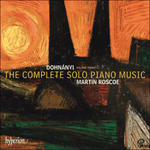While Ruralia hungarica may be Dohnányi’s most famous nationalist composition, his first work based on a traditional Hungarian melody is the Variations on a Hungarian Folksong, Op 29 (1917). In this work Dohnányi combined his newfound nationalism with his lifelong affinity for the theme-and-variations form. The theme is introduced in a very simple state, in unmetred block chords that are unadorned save for a few arpeggiated figures that terminate each of the folksong’s two halves. The first four variations alternate between slow and fast tempos, with the third variation imitating the Hungarian folk dulcimer known as the cimbalom. The tranquil fifth variation features an expansive, bell-like texture that requires both hands to play each of the bass and treble voices in order to fill out the rich harmonies. The sixth to the ninth variations gradually build up velocity and virtuosity back to the level of the fourth variation, before the work returns to a slow tempo one last time for the elaborately harmonized tenth variation. The work ends with a coda that returns to the serenity of the theme. The opening chords are replaced with even simpler octaves, with extended arpeggios at the ends of each phrase.
from notes by James A Grymes © 2015
Les
Ruralia hungarica sont peut-être la plus célèbre partition écrite dans la veine nationaliste que Dohnányi avait amorcée en 1917 avec ses Variations sur un chant populaire hongrois, op.29 (1917), première de ses œuvres construites sur une mélodie hongroise traditionnelle. Il y amalgama son récent nationalisme et son indéfectible goût pour la forme du thème et variations. Le thème est présenté tout simplement, dans des blocs d’accords non mesurés, sans ornements hormis pour quelques figures arpégées terminant chacune des deux moitiés du chant populaire. Les quatre premières variations alternent entre tempos lents et rapides, la troisième imitant le dulcimer traditionnel hongrois appelé cymbalum. La paisible cinquième variation affiche une expansive texture carillonnante requérant des deux mains qu’elles jouent chacune les voix de basse et de soprano pour combler les riches harmonies. Les variations 6 à 9 regagnent peu à peu en vélocité et en virtuosité, jusqu’à retrouver le niveau de la variation 4, puis l’œuvre revient une dernière fois à un tempo lent, pour une dixième variation à l’harmonisation complexe. Le tout s’achève sur une coda renouant avec la sérénité du thème. Les accords introductifs sont remplacés par des octaves plus simples encore, avec des arpèges prolongés à chaque fin de phrase.
extrait des notes rédigées par James A Grymes © 2015
Français: Hypérion
Während
Ruralia hungarica wohl Dohnányis bekannteste patriotische Komposition ist, handelt es sich bei den Variationen über ein ungarisches Volkslied, op. 29 (1917), um sein erstes Werk, dem eine traditionelle ungarische Melodie zugrundeliegt. In diesem Stück verbindet sich Dohnányis neuentdeckter Patriotismus mit der von ihm zeitlebens sehr geschätzten Thema und Variationen-Form. Das Thema wird in einer ganz einfachen Gestalt eingeführt: mit nicht metrisierten Akkordblöcken und ohne Verzierungen außer den wenigen Arpeggierungen am Schluß jeder Hälfte des Volksliedes. Die ersten vier Variationen wechseln im Tempo zwischen langsam und schnell; in der dritten Variation wird das als Cimbalom bekannte ungarische Hackbrett imitiert. Die ruhige fünfte Variation zeigt eine glockenartige Textur, in der beide Hände sowohl die Baß- als auch die Sopranstimme spielen müssen, um die reichen Harmonien auszufüllen. Die Variationen 6–9 erreichen nach und nach das Tempo und die Virtuosität der vierten Variation, bis die Musik in der kunstvollen zehnten Variation ein letztes Mal zu einem langsamen Tempo zurückkehrt. Das Werk endet mit einer Coda, die wieder die Klarheit des Themas aufweist. Die Akkorde des Anfangs werden durch noch einfachere Oktaven mit ausgedehnten Arpeggien am Ende jeder Phrase ersetzt.
aus dem Begleittext von James A Grymes © 2015
Deutsch: Christiane Frobenius


 Dohnányi: The Complete Solo Piano Music, Vol. 3
Dohnányi: The Complete Solo Piano Music, Vol. 3
